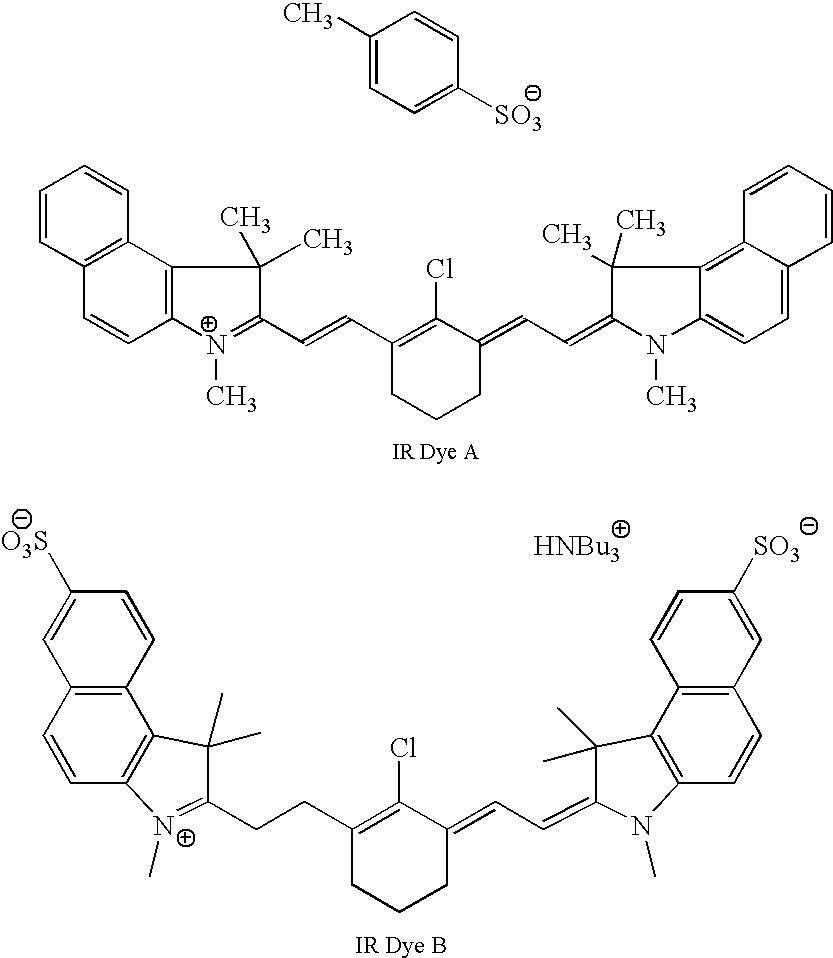Multilayer imageable elements
a technology of imageable elements and multi-layer printing, which is applied in thermography, photosensitive materials, instruments, etc., can solve the problems of time-consuming process and small change in mask dimensions, and achieve the effect of increasing the length of the press run
- Summary
- Abstract
- Description
- Claims
- Application Information
AI Technical Summary
Benefits of technology
Problems solved by technology
Method used
Image
Examples
example 1
[0114]This preparative example illustrates preparation of a copolymer comprising from 41.5 mol % of recurring units derived from N-phenylmaleimide, 21 mol % of recurring units derived from methacrylic acid, and 37.5 mol % of recurring units derived from N-(iso-butoxymethyl)acrylamide.
[0115]N-Phenylmaleimide (19.31 g), methacrylic acid (4.86 g), N-(iso-butoxymethyl)acrylamide (15.84 g) (Cytec Industries, Charlotte, N.C., USA), and 50:50 (v:v) dioxolane / ethanol (126.01 g) were placed in a 1 L reaction kettle fitted with a reflux condenser, nitrogen supply, thermometer, stirrer, and heating mantle. Nitrogen was bubbled through the reaction mixture for one hour. The reaction was heated to 60° C. under nitrogen and 2,2-azobisisobutyronitrile (AIBN) (0.054 g in 10 g of dioxolane / ethanol) was added. The reaction mixture was stirred under nitrogen at 60° C. for about 20 hours. The reaction mixture was slowly added to water (about 1 L), and the resulting precipitate filtered. The precipitate...
example 2
[0116]This preparative example illustrates preparation of a copolymer containing 41.5 mol % or recurring units derived from N-phenylmaleimide, 21 mol % or recurring units derived from methacrylic acid, 19 mol % or recurring units derived from methacryamide, and 18.5 mol % or recurring units derived from N-(iso-butoxymethyl)acrylamide. The procedure of Example 1 was repeated except that N-phenylmaleimide (21.26 g), methacrylic acid (5.35 g), methacrylamide (4.78 g), N-(iso-butoxymethyl)acrylamide (8.60 g) and 50:50 (v:v) dioxolane / ethanol (126.01 g) were used to prepare the copolymer. Yield: 75%.
example 3
[0117]This preparation example illustrates preparation of a copolymer containing 41.5 mol % of recurring units derived from N-phenylmaleimide, 21 mol % of recurring units derived from methacrylic acid, 19 mol % or recurring units derived from methacryamide, and 18.5 mol % or recurring units derived from N-(butoxymethyl)acrylamide. The procedure of Example 1 was repeated except that N-phenylmaleimide (21.26 g), methacrylic acid (5.35 g), methacrylamide (4.78 g), N-(butoxymethyl)acrylamide (8.60 g) (Cytec Industries, Charlotte, N.C., USA) and 50:50 (v:v) dioxolane / ethanol (126.01 g) were used to prepare the copolymer. Yield: 72%.
PUM
| Property | Measurement | Unit |
|---|---|---|
| mol % | aaaaa | aaaaa |
| mol % | aaaaa | aaaaa |
| mol % | aaaaa | aaaaa |
Abstract
Description
Claims
Application Information
 Login to View More
Login to View More - R&D
- Intellectual Property
- Life Sciences
- Materials
- Tech Scout
- Unparalleled Data Quality
- Higher Quality Content
- 60% Fewer Hallucinations
Browse by: Latest US Patents, China's latest patents, Technical Efficacy Thesaurus, Application Domain, Technology Topic, Popular Technical Reports.
© 2025 PatSnap. All rights reserved.Legal|Privacy policy|Modern Slavery Act Transparency Statement|Sitemap|About US| Contact US: help@patsnap.com

